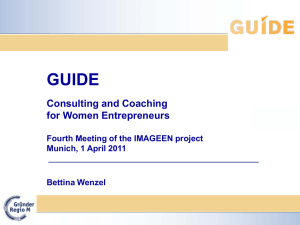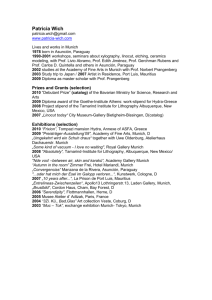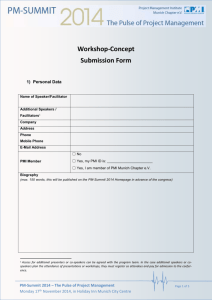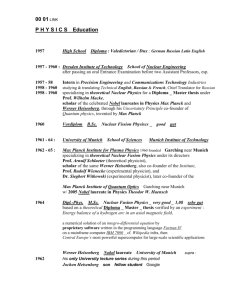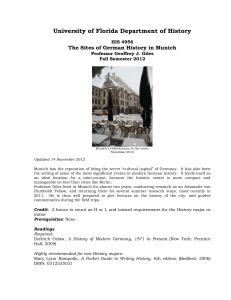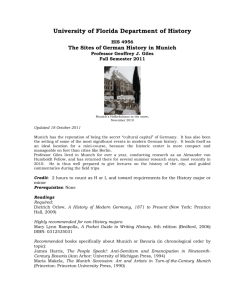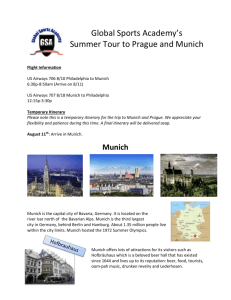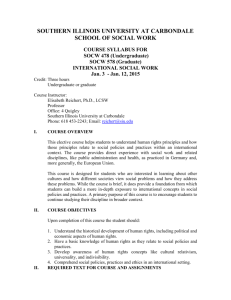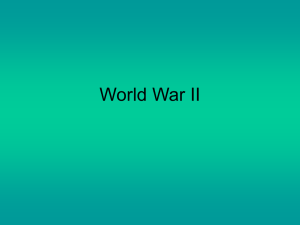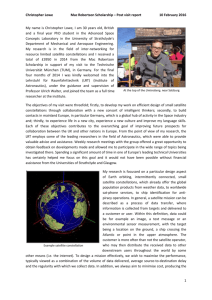Munich Find the title Facts
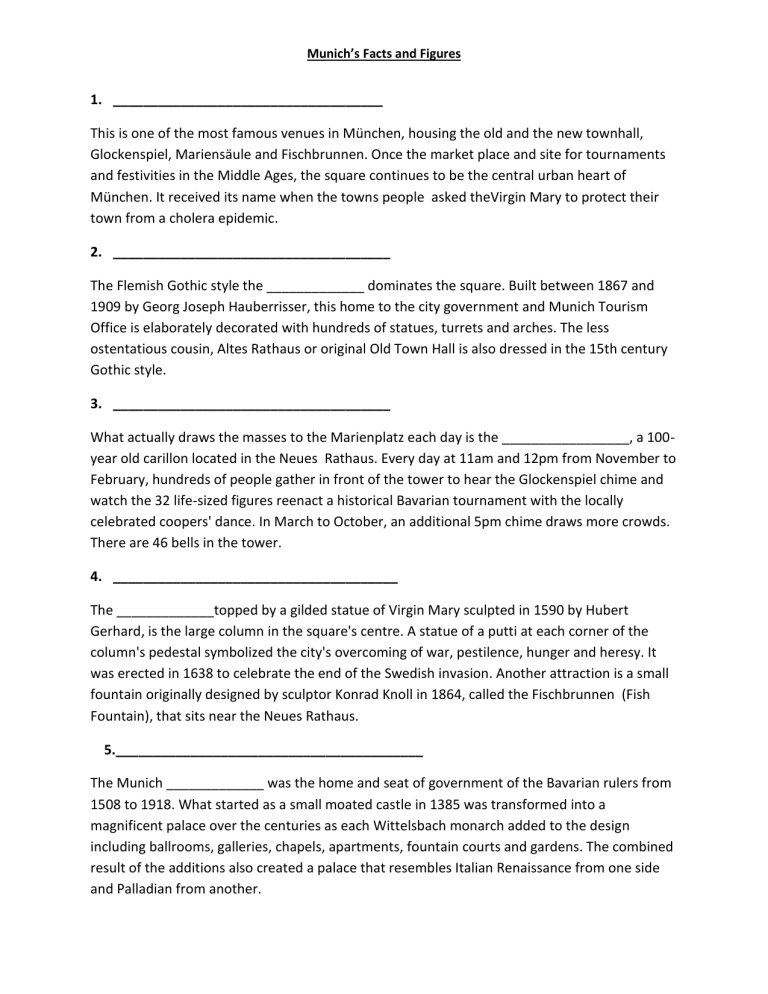
Munich’s Facts and Figures
1.
____________________________________
This is one of the most famous venues in München, housing the old and the new townhall,
Glockenspiel, Mariensäule and Fischbrunnen. Once the market place and site for tournaments and festivities in the Middle Ages, the square continues to be the central urban heart of
München. It received its name when the towns people asked theVirgin Mary to protect their town from a cholera epidemic.
2.
_____________________________________
The Flemish Gothic style the _____________ dominates the square. Built between 1867 and
1909 by Georg Joseph Hauberrisser, this home to the city government and Munich Tourism
Office is elaborately decorated with hundreds of statues, turrets and arches. The less ostentatious cousin, Altes Rathaus or original Old Town Hall is also dressed in the 15th century
Gothic style.
3.
_____________________________________
What actually draws the masses to the Marienplatz each day is the _________________, a 100year old carillon located in the Neues Rathaus. Every day at 11am and 12pm from November to
February, hundreds of people gather in front of the tower to hear the Glockenspiel chime and watch the 32 life-sized figures reenact a historical Bavarian tournament with the locally celebrated coopers' dance. In March to October, an additional 5pm chime draws more crowds.
There are 46 bells in the tower.
4.
______________________________________
The _____________topped by a gilded statue of Virgin Mary sculpted in 1590 by Hubert
Gerhard, is the large column in the square's centre. A statue of a putti at each corner of the column's pedestal symbolized the city's overcoming of war, pestilence, hunger and heresy. It was erected in 1638 to celebrate the end of the Swedish invasion. Another attraction is a small fountain originally designed by sculptor Konrad Knoll in 1864, called the Fischbrunnen (Fish
Fountain), that sits near the Neues Rathaus.
5._________________________________________
The Munich _____________ was the home and seat of government of the Bavarian rulers from
1508 to 1918. What started as a small moated castle in 1385 was transformed into a magnificent palace over the centuries as each Wittelsbach monarch added to the design including ballrooms, galleries, chapels, apartments, fountain courts and gardens. The combined result of the additions also created a palace that resembles Italian Renaissance from one side and Palladian from another.
Munich’s Facts and Figures
6._______________________________________________
The Dom zu unserer lieben Frau or _______________ is one of largest Gothic buildings in southern Germany and the largest in München with a capacity of 20,000 people. It serves as the cathedral of the Archdiocese of München and Freising. Commissioned by Duke Sigismund and completed by Jörg von Halsbach in 1488, the cathedral replaced a Marian chapel build on the site in the 12th century. The distinctive copper onion domes topping the towers, inspired by the
Dome of the Rock in Jerusalem, were only added in 1525. This symbolic landmark of München is also well known for its "dark" interior seemingly illuminated only by a tall chancel window.
Enormous pillars have hidden all the windows and according to legend, the devil was so delighted with the "darkness" that he left his footlike mark in the middle of the church.
7._______________________________________________
München's _____________________is a fresh produce market located in the city. It is well loved by residents. It's origin was the direct result of King Maximilian I's decree on 2 May 1807 to provide a larger market for cereals and other agricultural products in the city. Unfortunately, it was burned down in 1932 and only reopened in 2005. Over the years, the central market was significantly enlarged to include a butchers' hall, a tripe hall, stalls for poultry and venison, flower stands, pavilions for bakeries and fruit vendors, and a fish hall. More than just a market, the ____________ has also evolved into a social and cultural hub for the citizens of München.
8. _____________________________________________
Schloß _______________ or _______________ Palace owed its origin to the birth of Max
Emanuel, the son and heir to Elector Ferdinand Maria and his consort Henriette Adelaide of
Savoy. What began as a summer residence marked by a cube-shaped Italian villa in 1664 was enlarged by 5 succeeding Wittelsbach rulers. Even the small Italianesque garden of the
__________ was enlarged. In the 18th century, it was laid out in French style using Versailles as a model. In the 19th century the garden was remodeled in the more natural style of the English park. This was home of the Wittelsbach during the winter season.
9.___________________________________________
Aptly termed the ___________________of Masterpieces of Technology and Science, the
_________________ opened in 1925 is not just a place for science enthusiasts. It is one of
München's top attractions with 1.3 million visitors each year. Covering an area of 50,000 square meters, the ________________is the largest scientific-technological museum of its kind in the world with some 18,000 incredible artifacts and exhibits that mark important milestones in electricity, computers, telecommunication, aerospace, marine navigation, railways, chemistry,
Munich’s Facts and Figures astronomy, agriculture, mining and music. It provides a comprehensive understanding of science and technology over 100 years.
10. ___________________________________
Drivers and fans of ___________will be thrilled by a visit to _______________ just next to the company's headquarters. Apart from producing one of the safest cars, the Bavarian auto manufacturer offers an interactive museum, exhibitions, events and new car centre in a spectacular biomorphic complex that resembles a massive cloud. All brands of the groups including the MINI, Rolls-Royce Motor Cars, BMW i, BMW M and the BMW Group itself are presented in the _________________.
11._____________________________________
Building began on this project in 1966 to be finished in time for the 1972 Olympics. Constructed on the rubble of WWII outside Munich the park contains stadia, towers and parks.
12.__________________________________________
The ___________ Munich's famous “brauhaus” was founded in 1589 by the Duke of Bavaria,
Wilhelm V. It is one of Munich's oldest beer halls. It was originally founded as the brewery to the old Royal Residence, which at that time was situated just around the corner from where the beer hall stands today. The beer quickly became quite popular thanks to the first brewer,
Heimeran Pongratz, and the famous "Bavarian Beer Purity Law" of 1516 that stated that only natural ingredients could be used in the brewing process. In fact, the beer became so famous that it once saved the city from annihilation. When King Gustavus Adolphus of Sweden invaded
Bavaria during the Thirty Years' War in 1632, he threatened to sack and burn the entire city of
Munich. He agreed to leave the city in peace if the citizens surrendered some hostages, and
600,000 barrels of __________ beer.
13.___________________________________________
The ______________is a large square in central Munich which was developed in the early 19th century by Leo von Klenze and is at the southern end of the Ludwigstraße, developed at the same time. The square is named for the former concert hall, the Odeon, on its southwestern side. The name _____________ has come to be extended to the parvis (forecourt) of the
Residenz, in front of the Theatine Church and terminated by the Feldherrnhalle, which lies to the south of it. The square was the scene of a fatal gun battle which ended the march on the
Feldherrnhalle during the 1923 Beer Hall Putsch.
Munich’s Facts and Figures
14. ______________________________
The ________________ is a monumental loggia in Munich, Germany. It was built between 1841 and 1844 at the southern end of Munich's Ludwigstrasse next to the Palais Preysing and east of the Hofgarten. Previously the Gothic Schwabinger Tor (gate) occupied that place. The
__________ was a symbol of the honors of the Bavarian Army.
On Friday morning, 9 November 1923, the _______________ was the scene of a confrontation between the Bavarian State Police and an illegally organized march by the followers of Adolf
Hitler. When ordered to stop the marchers continued; the State Police felt threatened and opened fire. Four policemen and sixteen marchers were killed and a number were wounded, including Hermann Göring. As a result, Hitler was arrested and sentenced to a prison term. This was one of the efforts by the Nazis to take over the Bavarian State, commonly referred to as the Beer Hall Putsch.
15. ______________________________
_______________ is a square in Munich, Germany. Built in the style of European Neo-
Classicism in the 19th century, it is a center of cultural life. The area around _______________is today the home to the
Kunstareal, Munich's gallery and museum quarter. The square was designed as part of the representative boulevard Brienner Straße by Karl von Fischer working for Crown Prince Ludwig of Bavaria and laid out by Leo von Klenze. Fischer modeled the _______ on the Acropolis in
Athens. The concept was classical rigor embedded in living green, and so an expression of urban ideas of Ludwig I. who wanted to see cultural life, civic ideals, Catholic Christianity, royal administration and the military all together and embedded in green.
16. __________________________________
Since 1328 on _____________ beer had been brewed within the monastery of the
____________Brotherhood near the cathedral of Munich. After nearly 500 years of tradition, the secularization in 1803 and the following privatisation led to a privately owned company:
__________Bräu. In 1817 it moved to the Neuhauser Straße, the very same place where the renowned "Stammhaus" still stands today.
Munich’s Facts and Figures
17. ____________________________________
The ________________ German for ____________Garden, is a large public park in the center of Munich, Bavaria, stretching from the city center to the northeastern city limits. It was created in 1789 by Sir Benjamin Thompson (1753–1814), later Count Rumford (Reichsgraf von
Rumford) and extended and improved by his successors, Reinhard von Werneck (1757–1842) and Friedrich Ludwig von Sckell (1750–1823), who had advised on the project from the beginning.
With an area of 3.7 km2 (1.4 sq mi) (370 ha or 910 acres), the ______________ is one of the world's largest urban public parks, larger than New York's Central Park. The name refers to the style of gardening; the term English garden is used outside the English-speaking world to refer to the style of informal landscape gardening which was popular in Britain from the mid-18th century to the early 19th century, and is particularly associated with Capability Brown.
18. __________________________________ or ___________________
The ______ or ____________ in Munich is one of four main gates of the medieval city wall. It served as a fortification for the defence and is the westernmost of Munich's three remaining gothic town gates (Isartor, Sendlinger Tor and Karlstor). The Karlstor stands at the western end of the Neuhauser Straße, which was part of the salt road and the east-west thoroughfare of the historic old town. Thus, it divides the historic center of Ludwigvorstadt. Before Karlstor is the
Karlsplatz (Stachus), now part of the circle Altstadtring and one of the busiest points of Munich.
Between 1285 and 1347 a second fortification was built for Munich, under which the gate, then still Neuhauser Tor, was created. For the first time the _______ was mentioned in documents in 1302. The Karlstor over time was extended and fastened. When the shopping center _________-Einkaufszentrums was constructed in 1970, an escape tunnel with brick masonry was found, with the soldiers, even if civilians behind enemy lines to escape or enter. A short piece is on display at________-Einkaufszentrums.
19.___________________________________________
The____________________ is a city gate at the southern extremity of the historic old town area of Munich. It served as a fortification for the defense and is one of Munich's three remaining gothic town gates (______________ Isartor, and Karlstor).
20. _____________________________________
Inhabited since 1140 when it was first mentioned . It is Germany’s third largest city and is often known as the City with a heart. It is located approximately 110 km from the Southern border of
Germ any.
